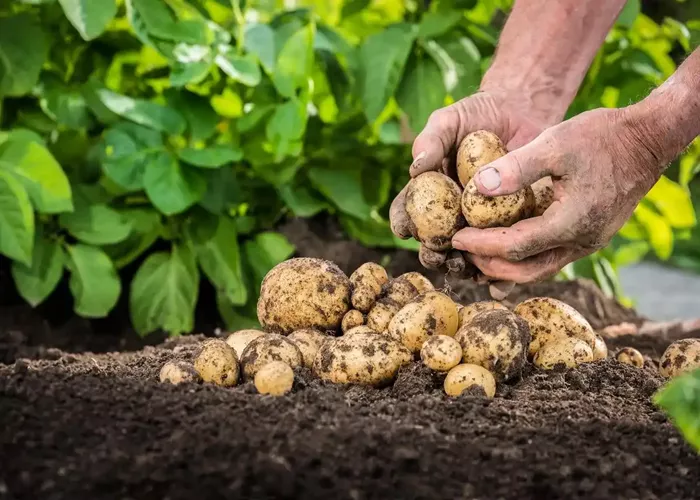Potato is very important for water demand during its growth. As a plant expert, I know the importance of proper watering for potato growth. This paper will elaborate the watering frequency and precautions in each stage of potato growth, and provide a scientific watering guide for growers.
Water Requirements During Potato Growth
The potato growth process can be divided into several stages, each of which has different water requirements. In general, potatoes need to follow the principle of small amounts of irrigation over the whole growth period to keep the soil moist but not wet.
1. Preemergence
Potatoes usually do not need to be watered between sowing and emergence. The focus of this phase is to increase the amount of light and prevent damage to the vault from bad weather. If the soil is too dry, you can pour small amounts of water in a special drought, but not too much.
2. Stage of emergence
After potato emergence, it is necessary to treat the seedlings covered by plastic film or cultivated in the open field in time. For potatoes covered with mulching film, it is necessary to manually assist to break the film in time; Potatoes cultivated in the open field should be hoed in time after rain or watering to break the hard shell and promote the smooth excavation of seedlings. Watering at this stage should be based on moisture content, if the soil moisture is moderate, can not water, so as not to reduce the ground temperature.
3. Seedling stage
The planting period is the key period for the robust growth of potato, and the main goal is to promote the growth of seedlings and build a good yield shelf. The watering principle at this stage is no drought, no watering, watering to avoid overcrowding the ridge top, and cultivation, soil cultivation, to create good potato conditions.
4. Potato setting period
When potatoes enter the potato setting stage, the demand for water increases rapidly. Especially in the flowering period, the potato block rapidly expanded, at this time should increase the amount of watering. It is usually recommended to water once every 7 days, two to three times in a row to keep the soil moist, and the soil water content is recommended to be about 85%. When watering, the principle of frequent watering with small water should be followed to avoid flooding with large water, so as not to cause soil compaction and affect the yield.
5. Harvest time
Watering should be stopped 7 to 10 days before potato harvest to avoid excessive moisture causing rot or a decline in quality of potato cubes.
The Specific Methods And Precautions Of Potato Watering
1. Master the “Six-Six Principle”
For farmers with less planting experience, watering can follow the “six six principle”, that is, irrigate once every six days for six hours at a time. This principle provides a basic irrigation guide for beginners, but in practice it should be flexibly adjusted according to potato growth and soil conditions.
2. Keep the soil moist
Throughout the growing period, the soil moisture of potatoes should be maintained at about 70% to 75% of the maximum field water capacity. Especially in the budding and flowering stage, soil moisture should be maintained at 80% to 85% of the field water capacity to meet the high water demand of potatoes.
3. Small water and frequent irrigation
When watering, the principle of frequent irrigation with small water should be followed to avoid flooding with large water. Do not water over the top of the ridge when watering to maintain permeability in the ridge and prevent soil compaction.
4. Avoid overirrigation
Excessive irrigation causes nitrogen fertilizer to wet the underside, leaves to turn yellow, and potatoes to be of inconsistent size. Where conditions exist, water-saving irrigation methods such as drip irrigation should be used as far as possible to avoid the problem of excessive irrigation and uneven watering.
5. Adequate soil moisture
Before sowing, ensure that the soil moisture is sufficient. If the soil moisture is insufficient, it is better to sow late than dry sowing. Adequate soil moisture is more important for mulch planting.
6. Spring potato watering points
When watering spring potato, it is necessary to master the timing and amount of soil moisture, seedling water and litmus water. The seedling water should be watered appropriately late, and the core flower water should be watered in time. Stop watering 7 to 10 days before harvest, and the ground must not collect water during harvest.
The Importance And Impact Of Potato Watering
Proper watering is essential for potato growth and high yield. The lack of water will cause the growth of potato to be hindered and the yield to decrease. Too much water can cause problems such as soil compaction and potato block rot. Therefore, growers should scientifically and reasonably arrange watering time and amount according to the growth stage of potatoes and soil conditions.
During potato growth, keeping the soil moist but not wet is key. By following the principle of small amount of irrigation, mastering the skills of small water irrigation, and flexibly applying watering methods such as the “six six principle”, growers can effectively meet the water demand of potatoes, and promote the healthy growth and high yield of potatoes.
Conclusion
watering is an essential part of the potato growing process. Through scientific and reasonable watering management, growers can create a good growing environment for potatoes and improve the yield and quality of potatoes. It is hoped that this paper can provide a practical watering guide for the majority of growers to help the potato harvest.
Related topics:
- Planting Potatoes in Flower Pots: Affecting Factors & Tips
- Unveiling the Botanical Mystery: Why Do Potatoes Flower?
- What Plants Do We Eat the Roots of?


